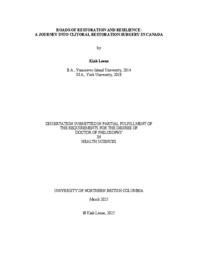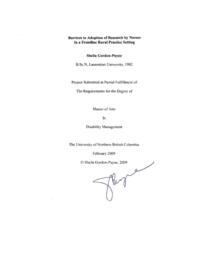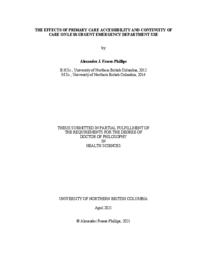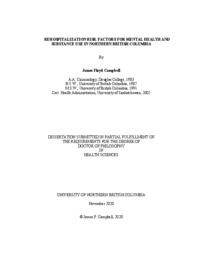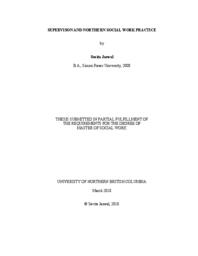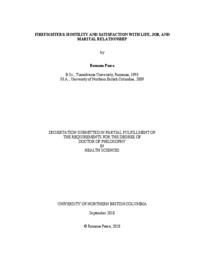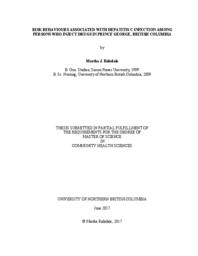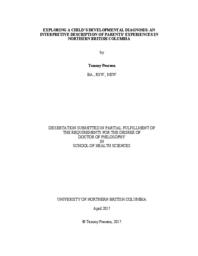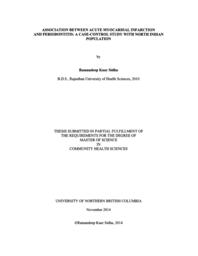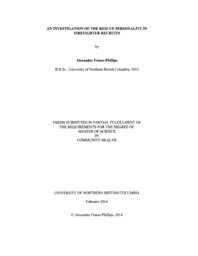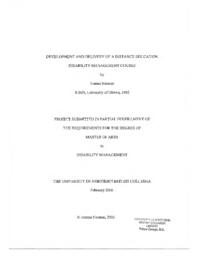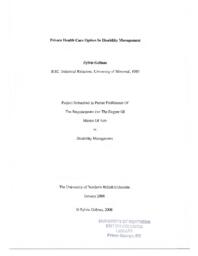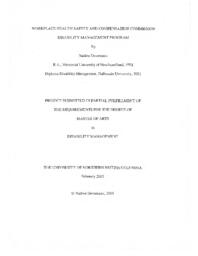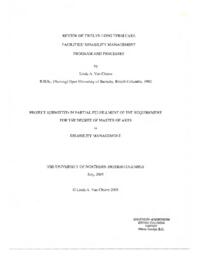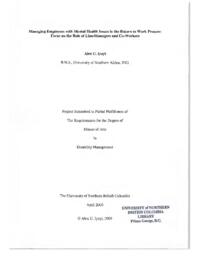Wagner, Shannon
Person Preferred Name
Shannon Wagner
Related Works
Content type
Digital Document
Origin Information
Content type
Digital Document
Origin Information
Content type
Digital Document
Description / Synopsis
Research on jurors and juror symptomatology has been conducted for many years; however, existing research has primarily been completed in the United States. What little research was conducted in Canada is now several years ago. Further, there is sufficient anecdotal evidence to suggest PTSD can and does occur as a result of serving jury duty. As such, this research sought to explore the relationship between jury duty participation and PTSD symptomology, as described by participants. This research is qualitative and involved two stages. First, participants (n=14) were asked to complete an online demographic survey that included a self-report measure for PTSD, the PCL-5. Second, participants (n=12) were invited to complete a one-two hour interview. Findings from the interviews were analyzed via thematic analysis. This research found three participants who met the criteria for probable PTSD (when using a cut-off score of 32). Overall, jurors in Canada echo previous research that states sources of symptoms relate to viewing disturbing images, deliberations, sequestering, and fear of making a mistake. New insight indicates fear associated with retaliation may be a major contributing factor for symptomology. Further, jurors whose life experiences relate to the trial type may be a contributing factor for symptomology. Policy and practice recommendations include improving information for jurors before they begin their service and providing more consistent follow-up support for jurors. Research should continue to explore the relationship between jurors and symptomology.
Origin Information
Content type
Digital Document
Description / Synopsis
Background/Aims. Since the early 2000s, Canada’s primary care system has undergone substantial reforms, including the incorporation of interdisciplinary teams and strategies to optimise accessibility. However, the effects of primary care accessibility and continuity of care on less-urgent emergency department (ED) use are unclear. Three studies were undertaken to investigate the effects of primary care accessibility and continuity of care factors on less-urgent ED use. Methods. Study One employed a cross-sectional analysis of responses to the Canadian Survey of Experiences with Primary Health Care to predict self-reported ED visit avoidability; Study Two employed a longitudinal time-to-event analysis of responses to Ontario’s Health Care Experience Survey linked with subsequent National Ambulatory Care Reporting System data to predict medically assessed less-urgent ED use; and Study Three employed time-series analyses of presentations to two northern British Columbia EDs following changes in walk-in clinic coverage. Results. Study One (n = 2,625) found no significant associations between self-reported ED visit avoidability and all measures of primary care accessibility and continuity of care. However, rural respondents reported greater ED visit avoidability. Conversely, Study Two (n = 34,686) found that all accessibility factors were significantly associated with medically assessed less-urgent ED use, including the presence of a regular PCP, the regular source of care, and the availability of after-hours care through the PCP. However, time with the same PCP was not associated with medically assessed less-urgent ED use. Rurality was also found to moderate the effect of after-hours care accessibility, with only rural respondents reporting a beneficial effect. Finally, Study Three found that changes in walk-in clinic coverage resulted in short-term impacts on less-urgent ED use, with a walk-in clinic closure resulting in an immediate increase in less-urgent presentations and an opening resulting in an immediate decrease. Conclusions. The findings of Studies Two and Three provide evidence that primary care accessibility factors are associated with medically assessed less-urgent ED use; however, the findings of Study One suggest that these factors do not influence self-perceived ED visit avoidability. Future studies should consider this discordance when measuring the impact of primary care accessibility on less-urgent ED use.
Origin Information
Content type
Digital Document
Description / Synopsis
Mental health and substance use (MH&SU) rehospitalization rates are used as indicators of treatment quality, to reduce costs, and measure efficacy. Research on this topic in rural Canadian hospitals and communities is lacking. This study used secondary data on 5159 patients (age 15 and older) hospitalized with International Classification of Disease (ICD) F code MH&SU diagnosis. These patients had 9103 admissions to 18 hospitals in Northern British Columbia during a five-year period, April 1st, 2010 through March 31st, 2015. ANOVA and Tukey Post Hoc tests were used to examine associations of two performance measures with five patient factors; community size, Indigenous culture, relationship status, employment status, and ICD F code diagnoses. The first measure was number of hospital readmissions. Of the 5159 patients with 9103 admissions, 3482 (67.6%) had one hospital admission during the five-year period. The remaining 1677 (32.4%) patients had 3944 (43.3%) of the hospitalizations). Patients whose cultural identity was Indigenous had over-representation and increased readmissions. Patients who were single and never in a relationship had increased hospitalizations. Patients whose ICD F coding for schizophrenia or psychosis had increased hospitalizations. The second measure was wait time for community MH&SU follow-up. Of the 5159 patients, 4512 (87.5%) had contact with community MH&SU during the five-years. Urban communities with specialized MH&SU services had reduced wait times for follow up. Patients whose cultural identity was Indigenous had longer wait times for community MH&SU follow-up. Patients who were divorced or separated had longer wait times. Patients with ICD F coding for schizophrenia or psychosis had shorter wait times for follow-up. The relationship between hospital readmission and community MH&SU follow-up was examined using logistic regression with the five factors. An inverse relationship was found between the two performance measures. Patients who did not have community MH&SU follow-up within 30 days had reduced odds ratio of readmissions, whereas patients who had follow-up within 30 days had increased odds ratio for readmissions. Although the study finds support for patient risk factors, evidence suggests approaches like a Decision Support Tool (DST) might provide reliability for intervention, and resource planning, as well as timely intervention.
Origin Information
Content type
Digital Document
Description / Synopsis
Background: The prevalence of Alzheimer’s disease (AD) and other dementias is perpetually increasing in Canada and worldwide with the aging baby boomer population. It is, therefore, important to identify risk factors for these major neurocognitive disorders, such as alcohol consumption, to mitigate the future burden on caregivers and the economy. The purpose of this study was to replicate previous research regarding the dose-response relationship between alcohol consumption and the odds of currently having AD or another dementia. The possibility of a sex effect moderating this relationship was also explored. Participants: Data were obtained for respondents to the combined 2015/16 cycles of the Canadian Community Health Survey who were aged 41 years or older at the time of the survey’s conduction (nweighted = 16,715,618). Methods: Logistic regression was used to crossectionally assess the relationship between various time- and frequency-related alcohol consumption exposures to outcome dementia status, while controlling for a number of demographic and risk factor variables. Results: A sex effect was identified for drinking at an average frequency of four to six times per week over the past year (p = 0.019, 95% CI: 0.03, 0.73) where women (ORw = 0.13) were more protected against currently having AD or dementia than men (ORm = 0.89) when compared to alcohol abstainers. Binge drinking two to three times per month (OR = 0.19, p = 0.015, 95% CI: 0.05, 0.73) and more than once per week over the past year (OR = 0.16, p = 0.007, 95% CI: 0.04, 0.61) significantly lessened the odds of currently having AD or dementia when compared against alcohol abstainers. A sex effect was present for those who were classified as very heavy drinkers (♂: 6+ drinks/day, ♀: 4+ drinks/day) over the past week (p = 0.018, 95% CI: 1.14, 39.41) where alcohol was protective against currently having AD or dementia in men (ORm = 0.29) and alcohol was a risk factor for currently having AD or dementia in women (ORw = 2.15) when both were referenced with alcohol abstainers. Conclusions: With the exception of very heavy drinker women, drinking alcohol was associated with a reduced likelihood of currently having AD or dementia and sex effects were identified for drinking at a moderate frequency over the past year and very heavy drinkers. However, these results should be interpreted with caution due to the possibility of selection, sparse data, and abstainer biases as well as misclassification error. The primary implication of this research is to inform future studies that a more thorough exploration of a sex effect influencing the relationship between alcohol consumption and having AD or dementia is warranted.
Origin Information
Content type
Digital Document
Description / Synopsis
Suicide is a global health issue that involves the biological, social, cultural, spiritual, and psychological state of an individual in addition to many other factors which interact and lead a person to Suicidal Ideation (SI) and Suicide Attempt (SA). Over the last decade, with the advent of large medical databases, there has been a tremendous rise in the use of Business Intelligence (BI) in the healthcare sector. Healthcare uses BI tools to transform raw data into meaningful information to extract the potential value of historical data. Timely diagnoses of mental health problems can assist experts to address it at an early stage and enhance patient’s quality of life. There is a critical need to examine the fundamental psychological well-being issues among the worldwide population, which may develop into more complex issues, if not considered at an early period. This research focuses on two main components: Data visualization and Predictive model. First, a mental health dashboard is created using an end to end approach in which mental health data is pre-processed, integrated, and visualized in the form of several reports. These reports display the aggregated results in visually appealing formats (i.e., graphs, tables, pie charts, and line graphs) and allow navigation to finer granularity reports via drill down and drill through reports. Second, a predictive model is built to forecasts Suicide Attempts (SA). Ontario Mental Health Reporting System (OMHRS) database obtained from CIHI (Canadian Institute for Health Information) is used to train and test the predictive model. This model uses advanced data mining algorithms, including Artificial Neural Networks, Decision trees, and regression. The outcomes of different data mining algorithms are compared with actual values to determine the accuracy of the model. In addition, a web form is created, which takes input from the user and calculates the probability of SA for a given patient. The objective of this research is to provide a better understanding of trends, outliers, and patterns to enable healthcare providers to make more informed decisions and decrease mortality rate due to suicide.
Origin Information
Content type
Digital Document
Origin Information
Content type
Digital Document
Origin Information
Content type
Digital Document
Origin Information
Content type
Digital Document
Origin Information
Content type
Digital Document
Origin Information
Content type
Digital Document
Origin Information
Content type
Digital Document
Origin Information
Content type
Digital Document
Origin Information
Content type
Digital Document
Origin Information
Content type
Digital Document
Origin Information
Content type
Digital Document
Origin Information
Content type
Digital Document
Origin Information
Content type
Digital Document
Origin Information
Content type
Digital Document
Origin Information
Content type
Digital Document
Origin Information
Content type
Digital Document
Origin Information
Content type
Digital Document
Origin Information

